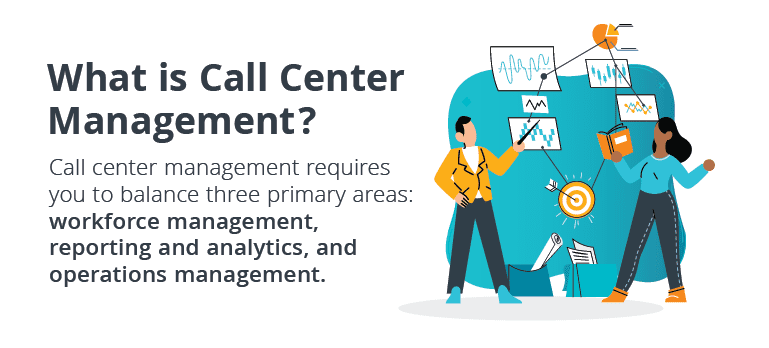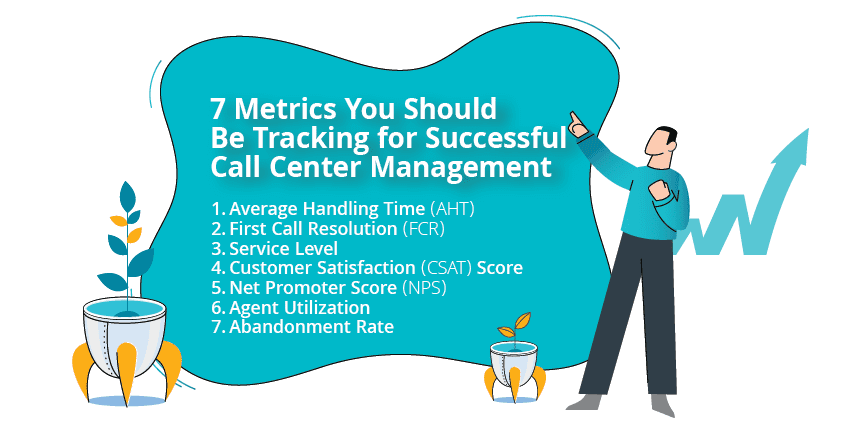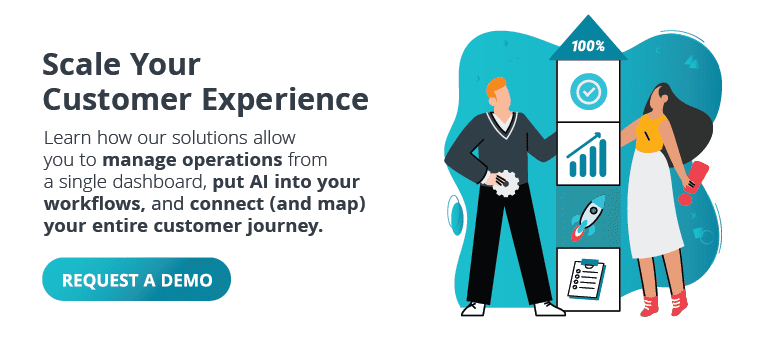Managing a call center isn’t easy.
It takes strategic vision and calls for several difficult in-the-moment decisions each day. It demands poise while handling busy and unpredictable daily operations. And it means managing and coaching staff to keep agents engaged and happy. Then, when a customer is less than satisfied with their service, that burden falls on the manager to resolve.
Essentially, call centers can only thrive if they have an effective call center manager. But that’s a lot to juggle. Where do you start?
This guide gives you the ins and outs of call center management, so you have the tools you need to grow as a leader, drive efficient operations, and keep agents and customers happy.
What Is Call Center Management?

Call centers are busy places. One study found that the average call center handles 200 calls per day, 1,000 per week, and 4,000 per month. And that’s just phone calls! Add emails, texts, social media messages, etc., and the number of customer interactions per day goes through the roof.
If you take your eye off the ball, your operations will crumble. And this can have a devastating impact on your customer experience. Effective call center management means being proactive — monitoring performance and operations and adjusting accordingly to stay agile. No matter what gets thrown your way.
Call center management requires you to balance three primary areas: workforce management, reporting and analytics, and operations management.
Workforce Management
As a manager, you manage the agents in your call center, empowering them to thrive in their work. This includes some administrative tasks like allocating resources, scheduling agents, and forecasting to ensure you have enough staff to match call volumes. All of this goes under the umbrella of workforce management. With the help of WFM tools, you can balance your agents’ workloads and skills to maintain service levels and keep your wait times low.
Reporting and Analytics
According to research by McKinsey & Company, 71% of consumers expect companies to deliver personalized interactions. Providing customized service starts with data.
Call center management uses reporting and analytics to track patterns, agent performance, and customer behavior. Then, you can use those insights to make informed decisions, identify areas for improvement, and drive operational efficiency.
Operations Management
To round out the balancing act, you have to manage your operations. This includes drafting and streamlining your processes and researching and implementing best practices. You should also test where technology can enhance your productivity and customer satisfaction.
These tasks serve your overall operations, helping you improve self-service, call routing, training, etc., so you can deliver exceptional customer experiences.
By balancing these three areas of work, call center management ensures agents and customers alike are satisfied, engaged, and supported.
What Is Operational Efficiency in a Call Center?
No matter the size of your call center, operational efficiency ensures your resources and tools provide the best customer experience. It’s the ability to maximize your output (i.e., the number of customers served or issues resolved) while minimizing your input (i.e., your agents’ time and energy).
In a recent survey of 1,300 CEOs, 77% say their primary focus is creating operational efficiencies and driving revenue growth. You see, they’re directly related. The more efficient your customer service, the more customers you retain for future sales. When your processes run smoothly, your business impact improves.
To increase efficiency, call center management needs to streamline workflows, cut out redundancies, and find places where technology supports productivity.
Check out our blog post on how AI can boost your operational efficiency.
14 Best Practices for Effective Call Center Management
In a nutshell, call center management aims to improve operational efficiency and deliver a seamless customer experience. Let’s dig into what this looks like with 14 best practices for more effective call center management.
Focus on Your Agents
Agents are the frontline ambassadors of your brand. Having the wrong fit or high turnover rates can be detrimental to your brand integrity and customer experience.
Investing in the right talent, providing comprehensive training, and fostering a supportive work environment is essential for agent retention.
1. Hire the Right People
You need to hire the right people. Identify individuals with the right skills and attitude. Prioritize qualities like empathy, problem-solving, and communication skills during hiring.
2. Effectively Onboard Agents
Those first 30 days of a job are crucial for long-term success. As an employee, it shapes your perception of the company and your boss. It also establishes whether you’ll have the tools you need to grow. Effective onboarding can improve new hire retention by 82%. Plus, it ensures your agents have a faster ramp to productivity.
3. Train Continuously
Training that stops after onboarding is a huge (and frequent) mistake. Ongoing training is essential for improving performance and engagement. In fact, as many as 92% of workers note that training has a positive impact on their job engagement. That’s not something to ignore. You can help your employees upskill and develop professionally with training and coaching. In turn, you’ll improve your customer service, too.
4. Engage Employees
A report out of Gallup found a substantial connection between employee engagement and 11 key performance outcomes. When your team is more engaged, you’re more productive and retain more agents. And your customers are more engaged, too, leading to more profit. In an industry where turnover is the noxious beast that billows through the revolving door, engaging your employees should be a top priority.
Invest in the Right Technology
Next, for effective call center management, you need the right tools. That means technology that’s scalable, flexible, and easy to learn. Here are a few call center tools worth your time.
5. AI and Automation
AI and automation tools make it easy to achieve faster, more effective service. Which makes life as a manager easier too. Your IVR can collect information and proactively answer questions from your customers. Chatbots can respond to basic customer questions, while sentiment analysis can gauge customer emotions to help agents tailor responses. Predictive analytics can anticipate customer needs for proactive problem-solving.
6. Robust Analytics and Reporting
Analytics and reporting tools are essential for data-driven decision-making. They let you capture call volumes, agent performance, and customer feedback. With this information, you have insight into operational strengths and weaknesses. You’ll be more empowered to identify trends, optimize processes, and allocate resources effectively. Plus, your performance will improve, and customers will be happier.
7. Omnichannel Capabilities
Seamless omnichannel communication is expected nowadays. With it, you can deliver a consistent and cohesive experience regardless of the channel. Integrating channels and centralizing customer interactions gives agents a full view of each customer’s journey. This facilitates smoother interactions and fosters stronger customer relationships.
8. Call Routing and IVR
If you want smoother service and higher customer satisfaction, efficient call routing and IVR systems are a must. Streamlined call routing helps you reduce wait times and improve first call resolution (FCR) and self-service. Intuitive IVR menus let customers self-select options and quickly reach the most appropriate agent. Ultimately, improving call routing and IVR not only boosts operational efficiency but also enhances the overall customer experience.
9. Cloud Capabilities
On-premises call center tech is in the past. With cloud-based technology, you can stay flexible and agile, scale, and remain cost-effective. Eliminating the need for on-prem infrastructure saves money and empowers agents by offering remote and flexible work models. Plus, cloud-based tech is often less costly, letting you invest in other vital technologies.
10. Integrations
Keep your tools connected for a unified view of customer data and streamlined operations. Integrations give agents access to comprehensive customer information. This information facilitates personalized interactions and improves issue resolution. Look for tools that integrate with your workforce management and analytics solutions for real-time insights and operational visibility.
11. Centralized Call Data
Data isn’t helpful if it’s siloed or distributed. Keep your call data centralized for comprehensive analysis. This gives you a holistic view of performance metrics, customer interactions, and operational trends. Ultimately, you’ll be empowered to make more informed decisions and drive continuous improvement in your team.
Improve Operations
So, you have the people and the tech figured out. Here are a few tips and best practices to improve your operations.
12. Focus on Proper Scheduling
You’re in trouble if you’ve got too many or too few agents available. Either your customers are stuck waiting, or agents are sitting stagnant (or looking for other gigs while they’re on the clock). Focus on efficient workforce scheduling to ensure staffing levels match call volumes. It will also reduce wait times and maximize agent productivity and satisfaction.
13. Improve Self-Service Resources
Digital self-service options can cut support costs by 75% and decrease wait times. Enhancing your self-service options empowers customers to resolve simple queries on their own (which most prefer). This reduces the burden on your agents and improves efficiency.
14. Gather (and Act on) Customer Feedback
Customer feedback helps your team grow and lets you offer more personalized service. Add feedback mechanisms to gather insights directly from customers. This can help identify pain points and drive continuous improvement initiatives. But gathering feedback is just the first step. Be sure to act on their feedback to enhance the customer experience.
7 Metrics You Should Be Tracking for Successful Call Center Management
Tracking metrics and setting goals for improvement are key to call center management. Here are a few metrics you should be monitoring in your call center.

1. Average handling time (AHT). AHT measures the average duration of customer interactions. Aim for a lower AHT for higher efficiency.
2. First call resolution (FCR). FCR reflects the percentage of customer issues that are resolved in the first interaction. The higher your FCR, the more effective your operations and the higher your customer satisfaction.
3. Service level. Service level defines the percentage of calls answered within a specified time frame. It’s a big picture look at your operations, tracking how timely you respond to customers.
4. Customer satisfaction (CSAT) score. CSAT gauges the level of satisfaction among customers. It offers insights into service quality and areas of improvement. (This one is key!)
5. Net promoter score (NPS). Tracking NPS helps you understand customer loyalty. NPS notes whether customers will recommend your brand to others and is a key indicator of long-term success.
6. Agent utilization. This metric measures agent productivity and tracks how much time agents spend on customer interactions. Track agent utilization to optimize workforce efficiency and resource allocation.
7. Abandonment rate. Your abandonment rate is the percentage of callers who hang up before reaching an agent. This one is a red flag for potential issues with wait times or call routing.
A Look at Broadvoice for Your Call Center
Make call center management simple with Broadvoice’s cloud-based call center and CCaaS solution.
Broadvoice offers enterprise-level features for businesses of any size. (Oh – and it’s incredibly cost-effective, too!). You can pick and choose the features you need, like call monitoring, a cohesive admin panel, and robust analytics and reporting. Then, you’ll have easy deployment, setup, use, and management. Plus, you get the training and support you need to onboard your team.
With Broadvoice CCaaS, you can send CSAT surveys to customers, craft a cohesive omnichannel experience, and scale with ease using surge licensing. Want to add AI tools to your workflow? Go.AI lets you automate responses, complete tasks, and trigger actions, like sending a message from your IVR, without involving an agent.
Ready to supercharge your call center management this year? Schedule a demo with one of our team members.











